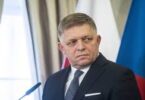WASHINGTON (Defensenews): The U.S. Navy conducted its first-ever aerial refueling between a manned aircraft and an unmanned tanker on June 4, with a Boeing-owned MQ-25 Stingray test vehicle performing its first midair tanking mission with a Navy F/A-18E-F Super Hornet.
The test mission out of MidAmerica Airport in Mascoutah, Ill., proved the unmanned tanker could successfully use the Navy’s standard probe-and-drogue aerial refueling method.
Once fielded, the MQ-25 will operate from aircraft carriers, refueling the air wing operating at sea and relieving the Super Hornet fleet of the tanking mission, which the Navy has said can at times account for more than one-third of Super Hornet flight hours during carrier air wing operations as the jets refuel each other or other aircraft in the air wing.
“This flight lays the foundation for integration into the carrier environment, allowing for greater capability toward manned-unmanned teaming concepts,” Rear Adm. Brian Corey, the Program Executive Officer for Unmanned Aviation and Strike Weapons, was quoted as saying in a Navy news release. “MQ-25 will greatly increase the range and endurance of the future carrier air wing – equipping our aircraft carriers with additional assets well into the future.”
During the test, a Navy Super Hornet approached the Boeing-owned MQ-25 T1 test vehicle, coming within 20 feet of the unmanned aircraft to conduct a formation evaluation and wake survey to measure the conditions before starting the fuel transfer, according to a Boeing news release. Once the measurements were taken, the MQ-25 extended its drogue, and the Super Hornet moved in to accept the fuel from the Aerial Refueling Store.
As the Navy and Boeing analyze data from the test, they’ll make any software updates that are needed as the MQ-25 testing schedule continues in the coming months.
The Boeing MQ-25 T1 test asset transfers fuel to a U.S. Navy F/A-18 Super Hornet on June 4, marking the first time in history that an unmanned aircraft has refueled another aircraft. The MQ-25 Stingray will assume the carrier-based tanking role currently performed by F/A-18s, allowing for better use of the combat strike fighters and helping extend the range of the carrier air wing. Boeing photo.
The Boeing MQ-25 T1 test asset transfers fuel to a U.S. Navy F/A-18 Super Hornet on June 4, marking the first time in history that an unmanned aircraft has refueled another aircraft. The MQ-25 Stingray will assume the carrier-based tanking role currently performed by F/A-18s, allowing for better use of the combat strike fighters and helping extend the range of the carrier air wing. Boeing photo.
The Navy plans to conduct deck handling demonstrations later this year in Norfolk, Va., where it will take the unmanned aircraft out to an aircraft carrier and make sure it can be safely moved around the hangar and the flight deck without impeding manned aircraft operations or posing a hazard to the dozens of sailors that work on the flight deck during air operations.
“This is our mission: an unmanned aircraft that frees our strike fighters from the tanker role and provides the Carrier Air Wing with greater range, flexibility and capability,” Capt. Chad Reed, the program manager for the Navy’s Unmanned Carrier Aviation program office, said. “Seeing the MQ-25 fulfilling its primary tasking today, fueling an F/A-18, is a significant and exciting moment for the Navy and shows concrete progress toward realizing MQ-25′s capabilities for the fleet.”
The June 4 test comes after 25 test flights of the T1 test vehicle since 2019.
Current testing is being conducted with a Boeing-owned vehicle. The Navy awarded Boeing a contract in 2018 for four test aircraft – plus a contract modification in 2020 for three more – which are set for delivery by 2024.






